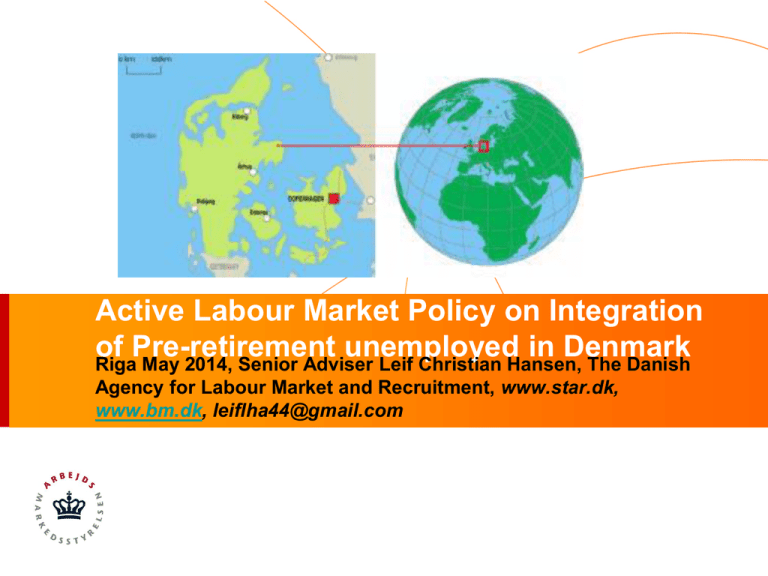Unemployment
advertisement

Active Labour Market Policy on Integration of Pre-retirement unemployed in Denmark Riga May 2014, Senior Adviser Leif Christian Hansen, The Danish Agency for Labour Market and Recruitment, www.star.dk, www.bm.dk, leiflha44@gmail.com Agenda and contents Key figures Flexicurity PES organisation and institutional set up Employability scheme and tools Pre-retirement before senior age Senior age pre-retirement Senior measures Senior self-activation (Senior Erhverv (Business)) Good practices and measures Conclusions Key figures 2013-2014 Population: 5,6 mill (16-66: 3,8 mill), Labour force: 2,9 mill, Employment rate: 76% (Female 72%), (55-64 years 62%). Unemployment March 2014: 1) (EU/OECD survey), 6,5% (EU 10,6%), Youth: 11,8% (EU 23,7%) 2) Long term unemployment: 1,7%, EU 5,1%, 3) NEET 15-24 years: 6,6%, EU 13,2%, (Not in Employment, Education or Training) Registered at the Job Centres: 5,1% (135,800 Persons), Male 4,9%, Female 5,3%, 15-24 years 3,5%, 25-29 8,0%, 50-59 4,9%, 60- 3,6% Unionization rate: app. 70 % Collective agreement coverage: 70-75 % Further adult training and education 31,6 %, EU 9,2 %, GNP: 2009 – 4.9%, 2012 -0.4, 2013 +0,2%, 2014 +1,6% Lab. budget 2014: app. 4% of GNP (2,3% active, 1,7% passive) Employment and Unemployment Employment rates: total, females, older (55-64): EU: 68% 63% 50% Latvia: 70% 68% 55% Hungary: 63% 57% 39% Denmark: 76% 72% 62% (55-59 years: 82%, 60-64 years 44% (60 years Early Retirement Pay)) Unempl. rates: total, females, youth, NEET, older: EU: 11,8% 12,0% 23,7% 13% n.a. Latvia: 11,6% 11,0% 23,9% 15% n.a. Hungary: 7,9% 8,3% 24,1% 15% n.a. Denmark: 6,5% 7,0% 12,6% 6,6% n.a. The Danish flexicurity triangle (flexibility + security) Low employment protection: Easy to hire and fire (external flexibility) Flexible labour market Unemployment benefits Income security Unemployment benefits, 2 years duration incl. activation (earlier 4 years) high compensation for lowwage groups (90%), average replacement rate app. 60-65% (For non-insured Social security benefits) High job mobility (23% turnover) 800.000 job openings (1 mill. before the crisis) 425.000 unemployment spells Active LMP Employment security: active labour market policy, activation, right and duty, individual job plan Unemployment benefits in Denmark Unemployment insurance Voluntary (app. 77 % of the labour force), 18-63 years Benefits 90 per cent of former income, maximum 815 DKK per day (109 Euro) – 5 days per week Time-limited inclusive activation, 2 years (earlier 4 years) Administered by State-approved, private unemployment funds Financing: 1) members contributions app. 520 Euro per year regardless of income and of unemployment level and individual risk 2) plus general taxes Early retirement pay from 60/62 years to 65 (optional) Acute Packages for consequences of reduction from 4 to 2 years in 2010: (Acute jobs, Special Training Benefit) and from 2014 Temporary Labour Market Benefit until 2016 Social assistance Family-based and means-tested (app. 80% of unempl. benefits) No tradable assets over 10.000 DKK (app. 1.330 Euro) Not time-limited Administered by local municipalities (reimbursement from the state) Financing: general taxes The Danish institutional setup (changes to be expected) Minister for Employment 27 unemployment Insurance funds Education, Training, Guidance 53 Youth Guidance Centres External service providers Danish Agency for Labour Market and Recruitment 4 Employment regions Government Municipalities 98 Social Welfare offices - Cash benefits National Employment Council 94 Integrated job centres for all job-seekers (insured and uninsured and people on sick leave) Full responsibility of the municipality, State subsidies Regional Employment Councils Local Employment Councils 98 municipalities 7 An overview The Minister for Employment goal: People from public benefit into employment – young people into education, (Long term target: to increase the work force) 4 Annual targets for the Job Centres 2014: 1)Young people to start on an education 2) Reduce the number of People on Disability Pension 3)Reduce the number of Long Term Unemployed 4)Cooperation with companies The Agency for Labour Market and Recruitment implementing and following up, 4 tools: 1) Legislation for jobseekers and job centres, 2) Economic incentives to the Municipalities 3) IT-systems Benchmarking (Jobindsats.dk) 4) Dialogue, (5. The Labour Market Balance) 4 Employment regions monitor, advice, help and assistance to the job centres The 98 municipalities manage the Job Centres, responsible for the contact with the unemployed and with people on sick leave and with the Enterprises Performance Management: The Knowledge Bank (Jobeffekter.dk) and Benchmarking (Jobindsats.dk) Adult Vocational Training and Education: The Ministry of Education Employability efforts (Activation) (changes to be expected) Focus on direct ways into employment, job search and job placement activities (self help) – and sanctions. Regular contact with the unemployed: Day-one registration (65 % on-line) and CV Job bank and CV bank – www.jobnet.dk Employability profiling (target groups/match groups) At least every 3 months personal contact Weekly online reporting to and from the job centre (job options) After 9 months: job plan and activation, below 30 years after 3 months, below 19 years after 2 weeks, above 60 years after 6 months: 3 groups of activation schemes for all unemployed, focus on the labour market: Guidance and upgrading of skills and qualifications: 60 % Practical work training in enterprises: 25 % Wage subsidies (private and public sector): 15 % The Danish match model Pre-retirement challenges and targets Pre-retirement before senior age (Disability) Reduce the number of People on Disability Pension/anticipatory pension, no people on DP without testing alternative options (ordinary jobs, flexi-jobs etc.) via Rehabilitation Programme and Rehabilitation Teams (ability testing and training) No people below 40 years on DP (unless absolutely no working ability) Flexi-jobs, People with permanent reduced working capacity. Short time work, full wage, wage subsidy to the private or public employer Social Enterprises Disability Pension (incl. possible ”Light duty job scheme”) The New Social Security Benefit Reform Focus on educating young people Duty to work for the social security benefits (utility effort) Better assistance to people to get closer to a job or an education, e.g. holistic effort with complex issues and mentor All young people below the age of 30 without an education have a duty to begin an education and will get assistance Assistance particularly for the education of lonely parents Activity allowance to young people not ready to begin an education Duty of intensive job search during the first three months Effective sanction system Mutual duty to support each other financially for cohabiting couples over the age of 25 Strengthened coordination between municipalities (job centres) and educational centres Initiatives on senior retention Senior pre-retirement (retention) Keep the seniors on the labour market as long as possible, and if unemployed then early activation The Welfare Reform (2006) and The Agreement on Later Retirement (2011) changed The State Old Age Pension (OAP) – later entrance, and the voluntary Early Retirement Pay/Pension (VERP) – later entrance and shorter benefit period No age protection legislation Collective agreements ”Social Chapters” for all age groups and potential age, senior and retirement provisions Senior jobs in the municipalities: A right for people over 55 years loosing entitlement to unemployment benefit. Until the age of Early Retirement Pay (60/62 years). Ordinary wage. State subsidy. Seniorpraksis.dk and The Fund for Better Working Environment and Labour Retention, se below Employability and training programmes, se below (Senior disability scheme/pension 5 years before old age pension) Enhance retention in private and public enterprises Seniorprakis.dk Information and advice on good senior policies at company level, e.g. awards to best enterprises The Fund for Better Working Environment and Labour retention – for all age groups The aim: ”A good and long working life for everybody” ”Senior starter kits” for enterprises to help seniors to stay on the job as long as possible in the best-suitable way ”Prevention self-help kits” for enterprises to prevent burnout and attrition Employment and training services to senior people Employability and training programmes – focus not on age but on the persons employment and training needs means participation in ordinary further training schemes on equal terms with other age groups, e.g. VEU (adult education and continuing training) and AMU (adult vocational training for skilled and unskilled workers) The ordinary activation programme: earlier activation for over 60 years but access to concrete programmes on equal terms with other age groups Self-activation, e.g. via Senior Erhverv (Senior Business), se below Negative side: 25% of managers in the public social sector and 10% of managers in private industry do not want to hire staff above 60 years. Self-activation, Senior Erhverv (Senior Business) (I) Self-activation, Senior Erhverv (II) Self-activation, Senior Erhverv (III) To find jobs or project tasks to unemployed senior workers Provide enterprises with competent and experienced staff 24 independent networks located all over Denmark – economic support from The Danish Agency for Labour Market and Recruitment 1.600 members on average (unemployed over 50 years) 650 found a job in 2013 Strategy for building up evidence WHY: Build policymaking on evidence Spent money wisely A systematic approach Collecting existing evidence Research reviews Building a Bank of evidence Developing new evidence Projects Randomized controlled trials Disseminate evidence Samspil.info www.ams.dk Dialouge Jobindsats.dk We know that ALMP works. But what part of it works? 17 out of 19 Danish and International studies find positive effects of private wage subsidy jobs in general. Our randomized social experiments as well as 35 out of 40 reviews show positive effects from job counseling. Still need for more knowledge about effective policies (especially for weaker groups of unemployed). For unemployed with lower labour market attachment we have evidence that wage subsidy job private and public have positive effects Evidence on successful AMLP: Intensive and individualized follow-up and contact/dialogue Demand-led training and education Wage subsidized jobs in private enterprises Employment and training activities in real enterprises combined with mentoring support for hard to place young people Source: The AMS Knowledge Bank, Jobindsats.dk Some specific measures Job rotation scheme: Ordinary staff (private and public) attend training and are replaced by unemployed on activation with wage subsidy up to 12 months Flexi jobs: People with permanent reduced working capacity. Short time work, full wage, wage subsidy to the private or public employer Senior jobs in the municipalities: A right for people over 55 years loosing entitlement to unemployment benefit. Until the age of early retirement (60 years). Ordinary wage. State subsidy. Employability Partnerships: To introduce young people to job and education - involves Youth Guidance Centres, Educational Institutions, Job Centres and Business Business Centres: Local enterprises and the job centre assist and help vulnerable group to be integrated in a concrete enterprise, Generation 1: disadvantaged and vulnerable people on social benefits, Generation 2 Long term social benefit recipients and people in a ressource program (ability testing) Production schools: Alternative entrance to VET offering individual courses based on practical work and production to young people without immediate qualifications to enter secondary education. History of modern Employment policy ”Enlarging the workforce” 1975-: extension of unemployment benefit period, early retirement pay, activation 1994: Right and duty activation, regionalisation and decentralisation, job rotation scheme, leave schemes. (2000 Flexicurity - Denmark and The Netherlands) 2002: ”More people at Work”: e.g. external service providers 2006: The Welfare Agreement e.g. later retirement, senior job 2008: Increase the labour force (Danish and international recruitment) plus The 9. februar. Labour Market Commission (later retirement) - 2009: labour supply (tax reform), crisis packages (e.g. financial sector, labour market measures), the new job centres (municipalities) - 2010: The Fiscal Consolidation Agreement e.g. reduced unemployment benefit period, - 2011: reduction of the early retirement scheme 2011: new government, kick start and some new ALMP initiatives 2012-13: Acute Package for LTU, Youth Packages, Reform on flexi-jobs and disability pension, Reform on State Education Fund, reform on social cash benefits, Competitive Power Package Expert Committee on ALMP spring 2014 (Carsten Koch Committee). Content and organisation of the employment policy.To be discussed in the Parliament Conclusions Increase the labour force Get vulnerable groups from public benefits into employment – ordinary jobs or flexi jobs, full time or part time Keep the seniors longer time on the labour market via changes in old age pension and retirement schemes Incentives for business to keep the senior workers longer time in the enterprises Employment and training measures – only few special senior measures but on equal terms with other age groups Senior jobs Current political discussion in Parliament on the content and organisation of the employment policy Thank you very much for your attention. It has been a privilege to be here








